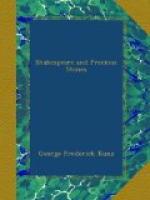ILLUSTRATIONS
William Shakespeare
(engraved by Martin
Droeshout)
Frontispiece
Five of the six authentic Shakespeare signatures
Diamond cutter’s shop, eighteenth century
From A portrait of queen Elizabeth
Printer’smark of Richard field
SHAKESPEARE AND PRECIOUS STONES
So wide is the range of the immortal verse of Shakespeare, and so many and various are the subjects he touched upon and adorned with the magic beauty of his poetic imagery, that it will be of great interest to refer to the allusions to gems and precious stones in his plays and poems. These allusions are all given in the latter part of this volume. What can we learn from them of Shakespeare’s knowledge of the source, quality, and use of these precious stones?
The great favor that pearls enjoyed in the sixteenth and seventeenth centuries is, as we see, reflected by the frequency with which he speaks of them, and the different passages reveal in several instances a knowledge of the ancient tales of their formation and principal source. Thus, in Troilus and Cressida (Act i, sc. 1) he writes: “Her bed is India; there she lies, a pearl”; and Pliny’s tales of the pearl’s origin from dew are glanced at indirectly when he says:
The liquid drops of tears that
you have shed
Shall come again, transform’d to orient
pearl.
Richard
III, Act iv, sc. 4.
First Folio,
“Histories”, p. 198, col. A, line
17.
This is undoubtedly the reason for the comparison between pearls and tears, leading to the German proverb, “Perlen bedeuten Traenen” (Pearls mean tears), which was then taken to signify that pearls portended tears, instead of that they were the offspring of drops of liquid. The world-famed pearl of Cleopatra, which she drank after dissolving it, so as to win her wager with Antony that she would entertain him with a banquet costing a certain immense sum of money, is not even noticed, however, in Shakespeare’s Antony and Cleopatra. In the poet’s time pearls were not only worn as jewels, but were extensively used in embroidering rich garments and upholstery and for the adornment of harnesses. To this Shakespeare alludes in the following passages:
The intertissued robe of gold
and pearl.
Henry V, Act
iv, sc. 1.
First Folio, “Histories”, p. 85 (page
number repeated),
col.
B, line 13.
Their harness studded all with
gold and pearl.
Taming of the Shrew, Introd.,
sc. 2.
“Comedies”, p. 209,
col. B, line 33.
Fine linen, Turkey cushions boss’d
with pearl.
Ibid., Act
ii, sc. 1.
“Comedies”, p. 217,
col. B, line 32.
Laced with silver, set with pearls.
Much Ado About Nothing, Act
iii, sc. 4.
“Comedies”, p. 112,
col. B, line 65.




